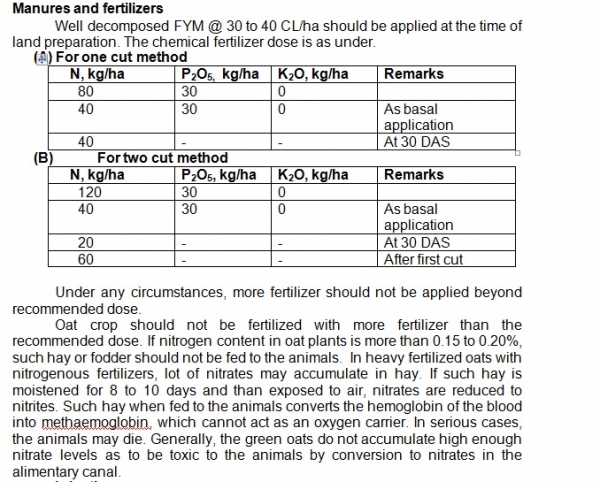Botanical Name: Avena sativa L.
Origin: Oats perhaps originated in Asia Minor
Family: Gramineae
Economic importance
It is most important cereal fodder crop grown in winter season. It is quick growing, palatable, succulent and nutritive crop and forms an excellent combination when fed along with other cold season legume/s to the animals. Oat is used as a green fodder, straw, hay or silage. Green fodder contains about 10-12% protein.
Land preparation
Two to three ploughing followed by harrowing and planking are sufficient to get friable and well levelled seedbeds.
Time of sowing
For one or two cuts of forage - sowing should be done on 15th November.
For continuous green forage production - sowing should be done at every 15 days interval start from the month of October and continued up to the month of December or different varieties vary in maturity period may also be grown on separate field.
Method of sowing: Drill method
Spacing: 25 to 30 cm between row to row
Seed rate: 100 kg/ha

Irrigation
Irrigation should be given to the oat crop when there is 50% available moisture in the soils and interval between two irrigations should be kept at 12 to 15 days. In one cut method, five to six irrigations are required, whereas, in two cut method, 2 more irrigations are needed.
Interculturing and weeding
Normally, there is no need of interculturing or weeding operations in this crop as the crop is grown very thick and plants have tillering habit, the growth of weed plants may suppressed. However, one interculturing and weeding should be done at 3 to 4 weeks after sowing.
Harvesting
1) In a one cut management method, the harvesting should be done at 70-80 days after sowing (at 50% flowering).
2) In a two cut management method, the first cut should be taken at 50 days after sowing and second cut should be taken at 50% flowering.
If crop is not harvested at 50% flowering i.e. if harvesting is delayed, the crude protein content decreased, whereas, dry matter, fiber, neutral detergent fiber etc may increase which lower the fodder quality.
Yield
1) One cut management method - 400 to 500 Quintal green fodder/ha.
2) Two cut management method - 500 to 600 Quintal green fodder/ha.
Variety: Kent-24, Kent-37, Palampur-1, Afferlee, Green mountain, IGFRI-S-3021
Research Station: IGFRI, Jhansi, In Gujarat, Anand (Main), Dhari (Sub).

